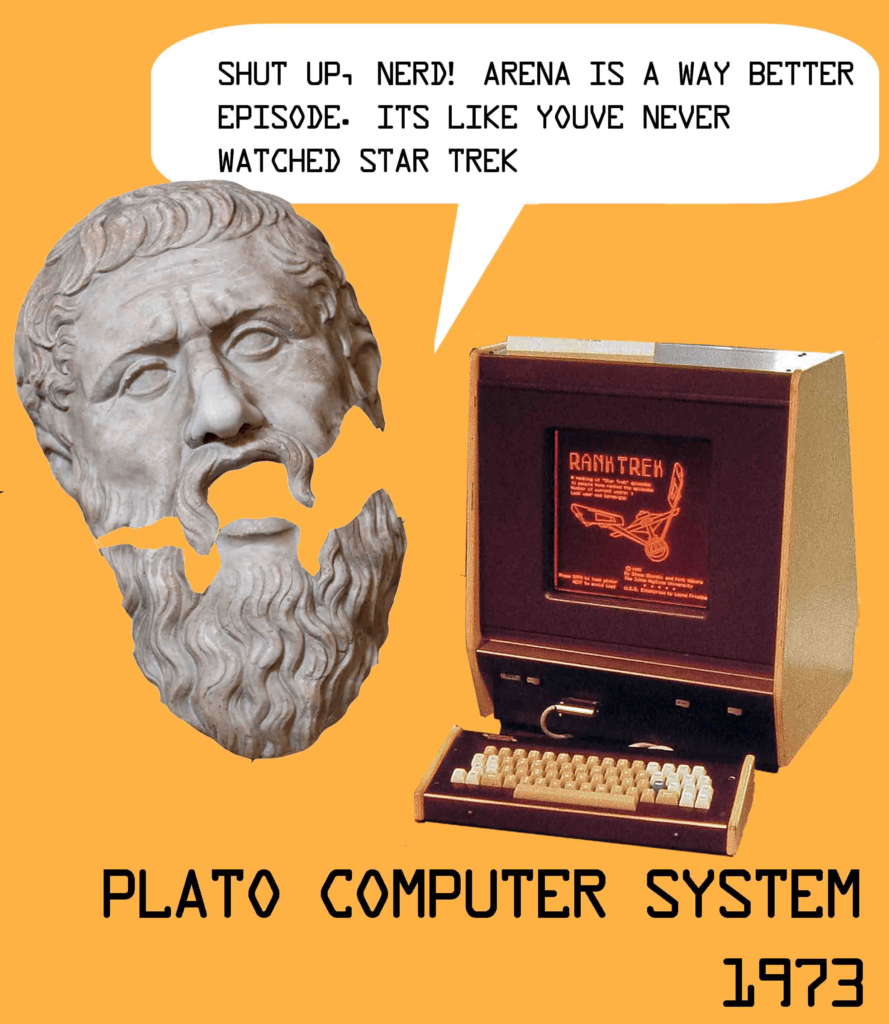By Onoir O’ Brien
Plato Overview
PLATO (Programmed Logic for Automatic Teaching Operations) was the first widespread computer-assisted instruction system. Starting in 1960, the ILLIAC I computer was built at the University of Illinois. By the end of the 1970s, several thousand graphics terminals were supported across the globe, running on nearly a dozen different networked mainframe computers. Many modern multi-user computing concepts were originally developed on PLATO, including forums, message boards, online testing, e-mail, chat rooms, picture languages, instant messaging, remote screen sharing, and multiplayer video games. A few such programs existed on PLATO before 1973, but they were not used much, probably because the user community was quite small and most of the terminals were still in a single building. In 1973, David R Woolley created Plato Notes one of the world’s first online message boards, and years later became the direct parent of Lotus Notes. By 1976, PLATO had developed a wide range of novel online communication tools, including Personal Notes (email), Term-Talk (instant messaging), Monitor Mode (remote screen sharing) and Emoticons. Doug Brown designed Talkomatic (chat rooms), a program that allowed a number of users to chat as a group. He wrote a simple prototype to show the concept and called it Talkomatica. The true magic of Talkomatic was that it instantly transmitted characters as they were typed, instead of waiting for a complete line of text. The screen was divided into several horizontal windows, each with a single participant. This allows all participants to type without turning their messages into a confusing jumble at once. Seeing messages appear literally as they were typed made the conversation feel much more alive than in line-by-line chat programs.
Selected Academic Literature
PLATO has been in operation for four decades, offering coursework (elementary through university) to UIUC students, local schools, prison inmates and other universities. Courses have been taught in a variety of subjects, including Latin, Chemistry, Education, Music and Primary Mathematics. The system included a number of features useful for pedagogy, including text overlay graphics, contextual assessment of free-text responses, depending on the inclusion of keywords, and feedback designed to respond to alternative responses. . As the value of a CDC-based solution disappeared in the 1980s, interested educators ported the engine to the IBM PC, and later to web-based systems. PLATO as a commercial product was licensed by Control Data Corporation (CDC), the manufacturer on whose mainframe computers the PLATO IV system was built. CDC President William Norris planned to make PLATO a force in the computer world but found that marketing the system was not as easy as he hoped. PLATO nevertheless built a strong follow-up in some markets, and the last PLATO production system did not close until 2006, coincidentally only a month after Norris died. PLATO’s communication tools and games formed the basis for an online community of thousands of PLATO users, which lasted for well over twenty years. In September 2006, the Federal Aviation Administration retired its PLATO system, the last system that ran the Plato software system on a CDC Cyber mainframe. Existing PLATL-like systems now include NovaNET and Cyber1.org.
Plato fun fact: Not only did PLATO engineers make major hardware breakthroughs with plasma displays and touch screens, but PLATO programmers also produced a long list of software, one of which was the first online newspaper in 1973!

References/Notes
Computer History Archives Project. 1960’s PLATO Computer System – Computer Aided Learning CAI CBT CDC Control Data Educational, 2016. https://www.youtube.com/watch?v=tTmWcGhlXqA.
Hack Education. ‘PLATO and the History of Education Technology (That Wasn’t)’, 25 January 2018. http://hackeducation.com/2018/01/25/plato.
‘PLATO (Computer System)’. In Wikipedia, 9 December 2020. https://en.wikipedia.org/w/index.php?title=PLATO_(computer_system)&oldid=993287591.
‘PLATO History: Timeline Archives’. Accessed 8 January 2021. http://www.platohistory.org/blog/timeline/.
‘PLATO: The Emergence of Online Community’. Accessed 20 December 2020. http://thinkofit.com/plato/dwplato.htm.
IEEE Spectrum: Technology, Engineering, and Science News. ‘SXSW 2018: A Look Back at the 1960s PLATO Computing System – IEEE Spectrum’. Accessed 8 January 2021. https://spectrum.ieee.org/tech-talk/tech-history/silicon-revolution/sxsw-2018-a-look-back-at-the-1960s-plato-computing-system.